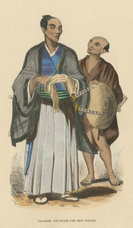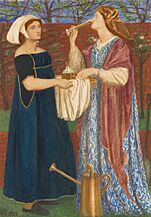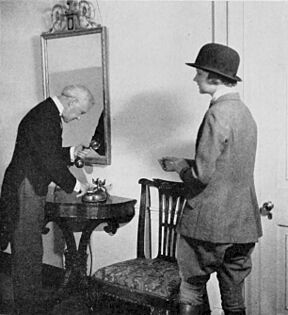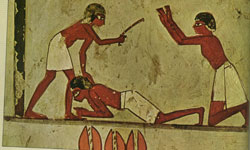Social class facts for kids
A social class is a way of grouping people in society. Think of it like different levels or groups that people belong to. The most common groups are the working class, middle class, and upper class.
Being part of a social class can depend on things like:
- How much education someone has
- How much money or wealth they have
- What kind of job they do
- Their income (how much they earn)
- The groups or communities they are part of
Social classes have existed in many societies throughout history, and they still exist today. Not all class systems are the same; they can be very different depending on the culture and time period.
Contents
History of Social Classes
Ancient Egypt's Social Structure
Social classes existed a very long time ago, even in Ancient Egypt. In Egypt, people who could read and write, like scribes, were often at the top. Wealthier people had more power and status. Ordinary people and those who were enslaved were at the bottom.
However, it wasn't impossible to move up. Sometimes, a person from a humble background could get an important job. Ancient Egyptians believed that men and women, no matter their class, were mostly equal under the law. Even a peasant could ask the vizier (a high official) for help if they felt they were treated unfairly.
Most people were farmers. But the land and its crops belonged to the state, temples, or noble families. Farmers also had to work on big projects like building or irrigation without pay. This was called a corvée system.
Artists and craftspeople had a higher status than farmers. They worked for the state or temples and were paid by the government. Scribes and officials were the highest class. They were known as the "white kilt class" because of their special white linen clothes. This upper class often showed off their status in their art and writings. Below the nobles were priests, doctors, and engineers.
It's not fully clear if slavery in ancient Egypt was like slavery we understand today. Some people who were enslaved could buy their freedom or even work their way up to a higher position. They were often treated by doctors if they got hurt at work.
Classes in Other Societies
In Ancient Greece, as the old clan system (where people were grouped by family) faded, social classes took its place. This happened as the population grew and society needed new ways to organize itself. Different jobs and skills also helped create these classes.
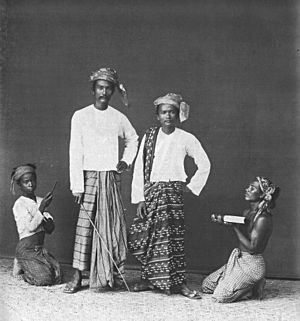
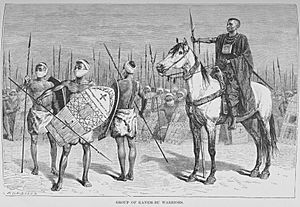
Historically, rules about social class often affected daily life, even what people could wear. For example, in some places, only high-ranking people or nobles were allowed to wear fancy clothes and jewelry. These were called sumptuary laws. They told people what was appropriate for their social rank. In Europe, these laws became common during the Middle Ages. However, these rules could change over time. Sometimes, the differences between classes, like between a rich patrician and a common plebeian in ancient Rome, almost disappeared.
A thinker named Jean-Jacques Rousseau had a big impact on ideas during the French Revolution. He believed that humans were born "naturally pure and good." He thought that problems in society, like inequality, came from how society developed. Rousseau also believed that private property (owning things like land or businesses) was a main cause of social problems. This is because private property can create inequality based on its value. Even though he thought a world without private property would be more equal, Rousseau accepted that some inequality would always exist.
Later thinkers during the Enlightenment period saw inequality as useful for society to grow and become successful. They also agreed that private property would lead to inequality. This is because people who own important resources can control them and profit from them. This can create competition between different social classes. This also leads to layers in society, keeping the lower, poorer classes separate from the higher, wealthier classes.
Some countries today, like India (caste system), Nepal, North Korea (Songbun), and Sri Lanka, still have clear social classes or similar systems. In societies with classes, there has often been conflict between them.
What Determines Social Class?
In societies where social classes exist, a person's class is often decided by:
- Their job
- Their education and any special training or qualifications they have
- Their income (how much money they earn)
- Their wealth (how much they own, like land, property, or businesses)
- Their family background
For example, in the United Kingdom, people are often described as belonging to the upper class, middle class, working class, or underclass.
What is a Class Society?
A class society is a type of society where who has power and how wealth is shared depends on who owns property and businesses. In these societies, people with more property and wealth are at the top. Those without access to these things are at the bottom.
In a class society, people are divided into different social layers, called social classes or castes. Researchers study how class societies work. They exist all over the world, in both developed and developing countries. Some theories suggest that class differences come directly from capitalism (an economic system). In a survey in Sweden, nine out of ten people agreed that they live in a class society.
Understanding Class Conflict
Class conflict, also called class struggle, is the tension or disagreement that happens in society. This is because people from different social classes often have different interests and desires, especially when it comes to money and power.
For a thinker named Karl Marx, the history of societies with classes was a history of class conflict. He believed that the rise of the middle class (the bourgeoisie) and the changes that came with it, like the growth of capitalism, often involved strong class conflict.
Marx thought that the unfairness and poverty that can happen in capitalism were already a form of class conflict. He believed that workers who earned wages would need to revolt to create a fairer sharing of wealth and political power.
What is a Classless Society?
A "classless" society is one where no one is born into a specific social class. In such a society, differences in wealth, income, education, or social network might still exist. But these differences would only be based on what a person achieves or experiences in their own life.
Since these differences are hard to completely avoid, people who support a classless society (like anarchists and communists) suggest different ways to achieve it. They also have different ideas about how important it is to create such a society.
Related pages
- Bohemianism
- Caste
- Constitution
- Constitutional economics
- Class struggle
- Clergy
- Household income in the United States
- Social status
- Working class
Images for kids
-
A symbolic image of three orders of feudal society in Europe before the French Revolution. It shows the rural third estate carrying the clergy and the nobility.
-
In many countries, the lowest group of the working class, the underclass, often lives in urban areas with low-quality public services.
-
Equestrian portrait of Empress Elizabeth of Russia with a servant.
See also
 In Spanish: Clase social para niños
In Spanish: Clase social para niños
- Class stratification
- Drift hypothesis
- Elite theory
- Elitism
- Four occupations
- Health equity
- Hostile architecture
- Inca society
- Mass society
- National Statistics Socio-economic Classification
- Passing (sociology)
- Post-industrial society
- Ranked society
- Raznochintsy
- Psychology of social class
- Welfare state


